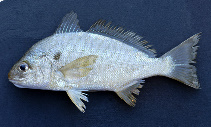Leiostomus xanthurus Lacepède, 1802
Spot croaker
個人による観察記録の追加 Fish Watcher
| Native range | All suitable habitat | Point map | Year 2050 |

|
| This map was computer-generated and has not yet been reviewed. |
| Leiostomus xanthurus AquaMaps Data sources: GBIF OBIS |
Upload your 写真 and ビデオ
Pictures | グーグルの画像Leiostomus xanthurus
Picture by NOAA\NMFS\Mississippi Laboratory
Pictures | グーグルの画像Leiostomus xanthurus
Picture by NOAA\NMFS\Mississippi Laboratory
United States (contiguous states) country information
Common names:
Spot
Occurrence: native
Salinity: brackish
Abundance: | Ref:
Importance: minor commercial | Ref: FAO, 1994
Aquaculture: | Ref:
Regulations: | Ref:
Uses: bait: yes;
Comments: Present in the continental shelf waters off the northeastern United States (Ref. 37512). This species is one of big five historically associated with the commercial fisheries of the lower Chesapeake Bay and the North Carolina sounds. It is taken by haul seine, gill net, and pound traps. Although its current market value is as a live bait fish, it remains in demand as a food fish (fried or salted and boiled) for the older generation. Spot generally exit the Chesapeake before cold weather. In unusual situations, however, they linger and if there is a cold snap, it can succumb in large numbers (Bernie Herman - blherman@email.unc.edu, pers. comm. 01/12).
National Checklist:
Country Information: https://www.cia.gov/library/publications/resources/the-world-factbook/geos/us.html
National Fisheries Authority: http://www.nmfs.gov
Occurrences: Occurrences Point map
Main Ref: Robins, C.R. and G.C. Ray, 1986
National Database:
Occurrence: native
Salinity: brackish
Abundance: | Ref:
Importance: minor commercial | Ref: FAO, 1994
Aquaculture: | Ref:
Regulations: | Ref:
Uses: bait: yes;
Comments: Present in the continental shelf waters off the northeastern United States (Ref. 37512). This species is one of big five historically associated with the commercial fisheries of the lower Chesapeake Bay and the North Carolina sounds. It is taken by haul seine, gill net, and pound traps. Although its current market value is as a live bait fish, it remains in demand as a food fish (fried or salted and boiled) for the older generation. Spot generally exit the Chesapeake before cold weather. In unusual situations, however, they linger and if there is a cold snap, it can succumb in large numbers (Bernie Herman - blherman@email.unc.edu, pers. comm. 01/12).
National Checklist:
Country Information: https://www.cia.gov/library/publications/resources/the-world-factbook/geos/us.html
National Fisheries Authority: http://www.nmfs.gov
Occurrences: Occurrences Point map
Main Ref: Robins, C.R. and G.C. Ray, 1986
National Database:
Common names from other countries
分類 / Names 共通名の | 類義語 | Catalog of Fishes(部類, 種) | ITIS | CoL | WoRMS | Cloffa
> Eupercaria/misc (Various families in series Eupercaria) > Sciaenidae (Drums or croakers)
Etymology: Leiostomus: Greek, leios = smooth + Greek,stoma = mouth (Ref. 45335).
More on author: Lacepède.
Etymology: Leiostomus: Greek, leios = smooth + Greek,stoma = mouth (Ref. 45335).
More on author: Lacepède.
Environment: milieu / climate zone / depth range / distribution range 生態学
分布 国々 | 国連食糧農業機関の区域 | エコシステム | 事件 | Point map | 導入 | Faunafri
Western Atlantic: Massachusetts to northern Mexico; absent in southern Florida.
サイズ / 重さ / 年齢
Maturity: Lm ? range ? - ? cm
Max length : 36.0 cm TL オス/雌雄の選別がない; (Ref. 7251); common length : 25.0 cm TL オス/雌雄の選別がない; (Ref. 3702); 最大公表体重: 450.00 g (Ref. 40637); 最大記録サイズ: 4 年 (Ref. 12193)
Max length : 36.0 cm TL オス/雌雄の選別がない; (Ref. 7251); common length : 25.0 cm TL オス/雌雄の選別がない; (Ref. 3702); 最大公表体重: 450.00 g (Ref. 40637); 最大記録サイズ: 4 年 (Ref. 12193)
Found usually over sandy or muddy bottoms in coastal waters to about 60 m depth. Occurs in nursery and feeding grounds in river estuaries during summer and fall. Juveniles often stay in the estuarine waters throughout the year. Feeds mainly on worms, small crustaceans and organic detritus. A small specimen of this species was caught in Tokyo Bay, Japan, probably brought in with the ballast water of a ship (Ref. 10325).
Life cycle and mating behavior 成熟 | 繁殖 | 放精 | 卵 | 生産力 | 幼生
主な参考文献
Upload your references | 参考文献 | コーディネーター | 協力者
Robins, C.R. and G.C. Ray, 1986. A field guide to Atlantic coast fishes of North America. Houghton Mifflin Company, Boston, U.S.A. 354 p. (Ref. 7251)
人間に対する脅威
Harmless
Human uses
水産業: 商業; ゲームフィッシュ: はい; 餌: occasionally
FAO(水産業: 代謝; publication : search) | FishSource | 私達の周りの海
より多くの情報
Population dynamics
成長のパラメーター
Max. ages / sizes
Length-weight rel.
Length-length rel.
体長組成
Mass conversion
補充
豊度
成長のパラメーター
Max. ages / sizes
Length-weight rel.
Length-length rel.
体長組成
Mass conversion
補充
豊度
Anatomy
カマ
Brain
Otolith
カマ
Brain
Otolith
Physiology
Body composition
Nutrients
酸素消費
水泳形態
泳ぐ速さ
Visual pigments
Fish sound
Diseases & Parasites
Toxicity (LC50s)
Body composition
Nutrients
酸素消費
水泳形態
泳ぐ速さ
Visual pigments
Fish sound
Diseases & Parasites
Toxicity (LC50s)
用具
E-book | 野外観察図鑑 | 検索表 | Length-frequency wizard | 生活史の基盤ツール | 目的のマップ | Classification Tree
| Catch-MSY |
特記事項
XMLをダウンロードして下さい
インターネットの情報源
Alien/Invasive Species database | Aquatic Commons | BHL | Cloffa | Websites from users | Check FishWatcher | CISTI | Catalog of Fishes(部類, 種) | DiscoverLife | ECOTOX | Faunafri | Fishtrace | GenBank(ゲノム, ヌクレオチド) | GloBI | GOBASE | GoMexSI (interaction data) | | Google Books | Google Scholar | Google | IGFA World Record | MitoFish | Otolith Atlas of Taiwan Fishes | 公共の水族館 | PubMed | Reef Life Survey | Scirus | SeaLifeBase | 生命の木 | Wikipedia(行く, 検索する) | World Records Freshwater Fishing | Zoobank | 動物に関する記録
Estimates based on models
Preferred temperature (Ref. 115969): 13.2 - 26.7, mean 24 (based on 314 cells).
Phylogenetic diversity index (Ref. 82804): PD50 = 1.0000 [Uniqueness, from 0.5 = low to 2.0 = high].
Bayesian length-weight: a=0.00891 (0.00570 - 0.01393), b=3.10 (2.97 - 3.23), in cm Total Length, based on LWR estimates for this species & (Sub)family-body (Ref. 93245).
栄養段階 (Ref. 69278): 3.2 ±0.1 se; based on diet studies.
回復力 (Ref. 120179): 高い, 15か月以下の倍増期間の最小個体群 (K=0.4; tmax=4).
Fishing Vulnerability (Ref. 59153): Low to moderate vulnerability (29 of 100).
Climate Vulnerability (Ref. 125649): Moderate to high vulnerability (47 of 100).




